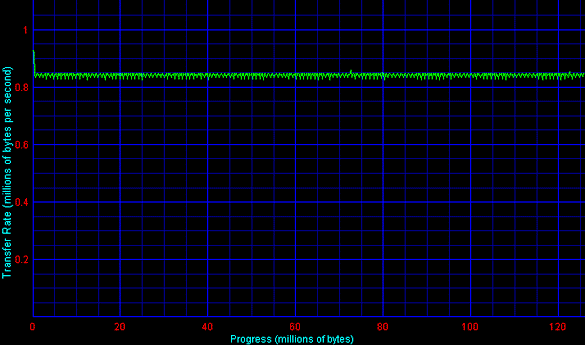Safer Stick: Biometric Flash Disk
Test Configuration
| Hardware | |
|---|---|
| Processor | Intel Pentium 4, 2.0 GHz 256 kB L2 Cache (Willamette) |
| Motherboard | Intel 845EBTIntel 845E ChipsetBIOS BT84520A.86A.0024.P10 |
| Memory | 256 MB DDR/PC2100, CL2.0 Micron/Crucial |
| Controller | i845E UltraDMA/100-Controller (ICH4)On-Board USB 2.0 (ICH4)On-Board FireWire |
| Graphics Card | ATI Radeon SDRAM, 32 MB |
| Network | 3COM 905TX PCI 100 MBit |
| OS | Windows XP Pro 5.10.2600 SP1 |
| Benchmarks & Measurements | |
| Performance Measurements | ZD WinBench 99 - Disk Inspection Test |
| Graphics Driver | 5.1.2001.0 (Windows XP Standard) |
| IDE Driver | Intel Application Accelerator 2.3 |
| DirectX Version | 9.0a |
| Screen Resolution | 1024x768, 16 Bit, 85 Hz refresh |
Benchmark Results
The Biometric Flash Disk's data transfer capacity is hampered by USB 1.1, which only offers a 1 MB/s transfer rate. A USB 2.0 interface would thus be better.
Conclusion
The Biometric Flash Disk could read and process fingerprints almost flawlessly. However, in order for it to become a perfect travel companion Plexuscom should equip it with an USB 2.0 port to ensure higher transfer rates up to 480 MBit/s. This way the use of the maximum storage capacity would really make sense. Right now, it takes approximately ten minutes until the available versions with 512 MB of storage capacity are full - this is definitely too much time.
Working and transporting important documents demand a high level of security. It's nice to see that at least one vendor has taken note of this market. Plexuscom's Biometric Flash Disk is also definitely a suitable product, no matter if you think of yourself as the new James Bond at home, or if the secure transportation of important documents is part of your life at work.
Get Tom's Hardware's best news and in-depth reviews, straight to your inbox.

Patrick Schmid was the editor-in-chief for Tom's Hardware from 2005 to 2006. He wrote numerous articles on a wide range of hardware topics, including storage, CPUs, and system builds.
